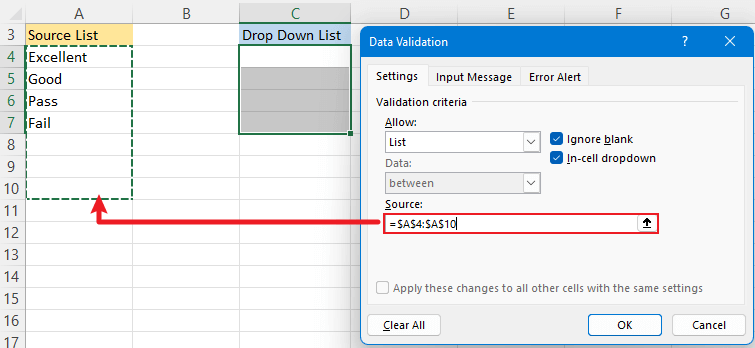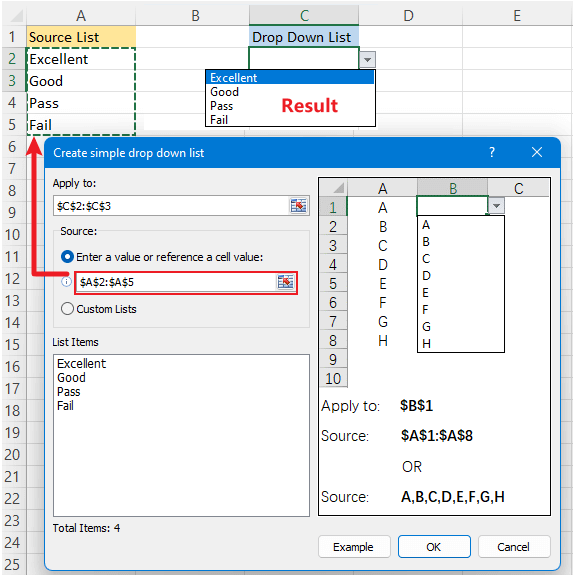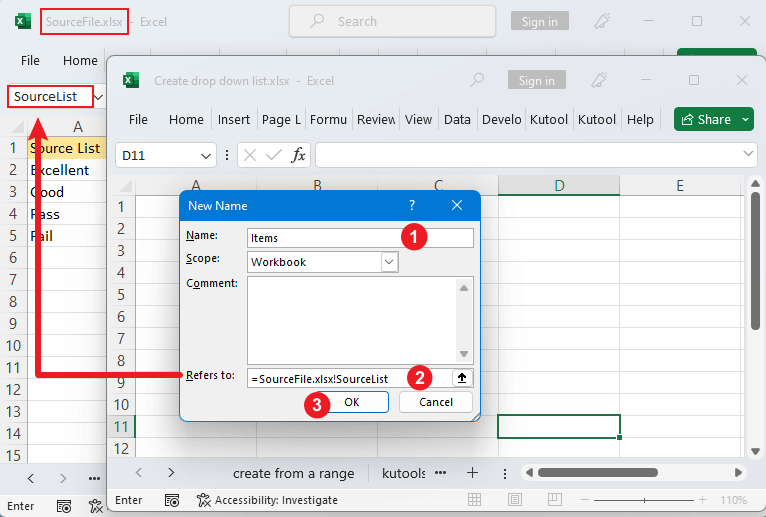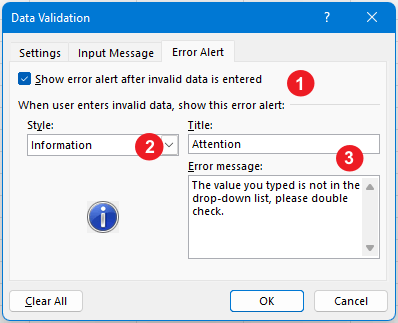Mastering Drop-Down Lists in Excel: A Comprehensive Guide
The drop-down list is a powerful feature in Excel that allows users to select values from predefined options instead of manual typing, providing better data entry accuracy and efficiency. Whether you are a beginner or an experienced Excel user, understanding and utilizing drop-down lists can greatly enhance your productivity and data management capabilities. In this article, we will step-by-step introduce different ways to create a drop-down list in Excel.
Video: Create a drop down list
Create a drop-down list
Let's start to learn how to create a drop-down list in Excel.
Create a drop-down list by manually input
Step 1: Select the cell(s) that you want to place the drop-down list

Step 2: Go to click Data tab, and click Data Validation

Step 3: Specify settings in the Data Validation dialog
Under Settingstab, please specify below settings:
- Choose Listfrom Allowdrop-down list;
- Type the items that you want to display in the drop-down list in the Source section, separate them by a comma;
- Click OK.

Result:
Now the drop-down list has been created.

Advantages of this method: Do not need a worksheet or range to place the source list.
Drawbacks of this method: If you want to add, remove or edit the items of the drop-down list, you need to go to Data Validation dialog to reedit the items in Source box manually.
Before proceeding with the methods below to create a drop-down list, you need to determine or create the items that you want to include in the drop-down list. This is referred to as the 'source list,' which should be organized within a specific range.
Make sure each item of the source list is in a separate cell. This list can be in the same sheet of the newly created drop-down list, another sheet or another workbook.

Create a drop-down list from a range
To create a drop-down list based on a range of cell values, please follow below steps:
Step 1: Select the cell(s) that you want to place the drop-down list
Step 2: Go to click Data tab, and click Data Validation

Step 3: Specify settings in the Data Validation dialog
Under Settingstab, please specify below settings:
- Choose Listfrom Allowdrop-down list;
- Click selection icon
 to select the source list in the Sourcesection;
to select the source list in the Sourcesection; - Click OK.

Result:
Now the drop-down list has been created.

Advantages of this method: You can modify your drop-down list by making changes in the referenced range (source list) without having to edit the items one by one in the Source section of the Data Validation dialog.
Drawbacks of this method: If you want to add items below or remove items from the drop-down list, you need to update the referenced range in the Source section of the Data Validation dialog. To automatically update items based on the source list, you should convert the source list to a table.
Tips:
If you prefer not to convert the source list into a table or manually update the referenced range in the Data Validation dialog when adding new items, here are two tips that can automatically update the drop-down list while adding new items in the source list.
When you select the source list in the Data Validation, include a few empty cells at the bottom of the source data, you can add new items to the source list by typing in the empty cells.

Insert new rows within the source list, then type the new items into the source list, then the drop-down list will be updated.
Create a drop-down list with Kutools
Here is a handy feature – Create simple drop-down list of Kutools for Excel can let you quickly and easily create a drop-down list with fewer clicks. Here is how to do:
- Select cell(s) to place the drop-down list;
- Click Kutoolstab, and click Drop-down List > Create simple drop down list;
- Select the range of cells (or directly type items separated by a comma) that you want to show in the drop down list, click OK.

Notes:
- Before using this feature, please install Kutools for Excel first. Click to download and have free a 30-day trial.
- Apart from this feature, there are other handy features for creating advanced drop-down lists easily, such as create a dependent drop-down list, create a drop-down list with multiple selections, create a drop-down list with checkboxes, and so on.
Create a drop-down list from a table (dynamic)
If you want to create a dynamic expandable drop-down list that updates automatically as you add or remove items from the source list, you should place the source data into an Excel table.
Step 1: Convert the source list to a table
Select the source list and click Insert> Table, and in the Create Table dialog, if the selection includes column header, please tick My table has headers, then click OK.

Step 2: Select the cell(s) that you want to place the drop-down list
Step 3: Go to click Data tab, and click Data Validation

Step 4: Specify settings in the Data Validation dialog
Under Settingstab, please specify below settings:
- Choose List from Allowdrop-down list;
- Click selection icon
 to select the table range (excluding header) in the Sourcesection;
to select the table range (excluding header) in the Sourcesection; - Click OK.

Result:
The drop-down list has been created.

And when you add or remove items from the source table, the drop-down list will be updated at the same time.

Advantages of this method: You can modify your dropdown list by making changes in the source table, including editing existed items, adding new ones or removing items.
Drawbacks of this method: None.
- To enable automatic updating of the drop-down list when new items are added to a table, follow these steps:
- Click on the last item in the table.
- Press the Enter key to move to the next cell.
- Enter the new item in the cell, and it will automatically be included in the drop-down list.
- If the table does not automatically expand range, please go to File > Options > Proofing to clickAutoCorrect Options, and check Include new rows and columns in table Automatically as you work option under AutoFormat As You Type tab.
Create a drop-down list from a range name
If you will create drop-down lists in multiple sheets based on a same source list, I recommend you to create a range name for the source list for easily referenced to.
Step 1: Create a range name for the source list
Select the source list and go to the name box (beside the formula bar), and type a name for it (the name cannot contain space or other special characters), then press Enterkey to finish.

Step 2: Select the cell(s) that you want to place the drop-down list
Step 3: Go to click Data tab, and click Data Validation

Step 4: Specify settings in the Data Validation dialog
Under Settings tab, please specify below settings:
- Choose Listfrom Allowdrop-down list;
- Type an equal sign and followed by the name you set in step 1 in the Source section like
You can also click on the Source texbox and press F3 key to open Paste Name dialog, then choose the range name you want from the list, click OKto insert it to the textbox.=SourceList - Click OK.

Result:
The drop-down list has been created.

Advantages of this method: You can easily and quickly create drop-down lists across multiple sheets by typing the name into the Source section in Data Validation dialog.
Drawbacks of this method: If you want to add items below or remove items from the drop-down list, you need to update the named range in the Name Manager.
Create a drop-down list from another workbook
If the source list and the to-be-created drop-down list are in different workbooks, when you select the source list in the Sourcesection of Data Validation dialog, an alert will pop out to prevent the creation.

Here this part will tell you how to create a drop-down list from another workbook.
Step 1: Create a range name for the source list in source workbook
In the source workbook, select the source items that you want them appear in the drop-down list. Then go to the Name Box which is next to the Formula Bar, type a name, such as "SourceList".

Step 2: Define a name that references your source list in the drop-down list workbook
Enable the workbook where you want to create a drop-down list, click Formula> Define Name.
 Define Name "/>
Define Name "/>In the popping New Name dialog, set as below:
- Type a name in the Name box, such as Items;
- Type an equal sign followed by the source workbook name and the name you defined for the source list in step 1 in the Refers to box, such as
=SourceFile.xlsx!SourceList - Click OK.

- Usually, SourceFile is the name of the source workbook with the file extension. If there is no file extension, simply follow it with an exclamation mark (!) and the range name. If the workbook name contains spaces or non-alphabetical characters, you should enclose the workbook name with single quotation mark like this:
='Source File.xlsx'!SourceList - Do not forget using exclamation mark between the workbook name and ranged name.
Step 3: Select the cell(s) that you want to place the drop-down list
Step 4: Go to click Data tab, and click Data Validation

Step 5: Specify settings in the Data Validation dialog
Under Settingstab, please specify below settings:
- Choose List from Allow drop-down list;
- Type an equal sign followed by the name you defined in step 3 in the Source section, like
=Items - Click OK.

Result:
The drop-down list has been created.

Drawbacks of this method: If the source workbook is closed, the drop-down list cannot work. And the drop-down list cannot update when the new items are added in the source list.
Error Alert (allow other entries)
By default, the drop-down list only allows values contained in the list to be entered into a cell. When you enter a value that does not exist in the drop-down list and press the Enter key, an error alert will show up, as shown in the screenshot below. When you click the Retry button, the entered value is selected for re-editing. Clicking the Cancel button will clear the entered value.

If you want to allow users to type other values and stop the error alert showing, you can do as these:
Select the drop-down list cells that you want to stop the error alert, click Data> Data Validation.
In the Data Validation dialog, under Error Alert tab, untick the Show error alert after invalid data is enteredcheckbox. Click OK.

Now when users type other values, there is no error alert showing up.
If you want to allow users to type other values but also show an alert for reminding them, please do as these:
Select the drop-down list cells that you want other values typed in, click Data> Data Validation.
- In the Data Validation dialog, under Error Alert tab:
- Keep the Show error alert after invalid data is enteredcheckbox ticked;
- Select Informationfrom Styledrop-down list;
- Specify the Title and Error message, click OK.

From now on, when users type other values, a dialog pops out to remind, click OKto remain the typed value, click Cancel to clear the entered value.

- You can also select "Warning" from the Style list and provide a Title and Error Message. This option functions similarly to "Information," but displays a yellow warning icon with an exclamation mark instead.
- If you are not sure what title or message text to type, you can leave the fields empty. Excel will display the default alert.
Input Message
When creating a drop-down list, you can add an input message to remind users to select items from the drop-down list when selecting a cell, or other information you want to show.
1. Select the drop-down list cells that you want to add an input message, click Data> Data Validation.
2. In the Data Validation dialog, under Input Message tab
- Keep the Show input message when cellis selected checkbox ticked;
- Specify the Titleand Input message, click OK.

Now, when users select the cell of drop-down list, a yellow textbox with information you provided shows up.

Other notes
By default, when a drop-down list is created, the "Ignore blank" checkbox is selected. This means that users can leave the cells blank without an alert popping.
If the "Ignore blank" checkbox is unticked, the blank cells in the range will be treaed as invalid entries, the alert will pop out.
If you want to change the order of the items in the drop-down list, you could rearrange the source list.
If the Data Validation feature is disabled, it is possible that you are working in a protected worksheet. To enable Data Validation, simply unprotect the worksheet and then apply the desired Data Validation settings.
Best Office Productivity Tools
Supercharge Your Excel Skills with Kutools for Excel, and Experience Efficiency Like Never Before. Kutools for Excel Offers Over 300 Advanced Features to Boost Productivity and Save Time. Click Here to Get The Feature You Need The Most...
Office Tab Brings Tabbed interface to Office, and Make Your Work Much Easier
- Enable tabbed editing and reading in Word, Excel, PowerPoint, Publisher, Access, Visio and Project.
- Open and create multiple documents in new tabs of the same window, rather than in new windows.
- Increases your productivity by 50%, and reduces hundreds of mouse clicks for you every day!
All Kutools add-ins. One installer
Kutools for Office suite bundles add-ins for Excel, Word, Outlook & PowerPoint plus Office Tab Pro, which is ideal for teams working across Office apps.
- All-in-one suite — Excel, Word, Outlook & PowerPoint add-ins + Office Tab Pro
- One installer, one license — set up in minutes (MSI-ready)
- Works better together — streamlined productivity across Office apps
- 30-day full-featured trial — no registration, no credit card
- Best value — save vs buying individual add-in
Table of contents
- Video: Create a drop down list
- Create a drop-down list
- By manually input
- From a range
- By Kutools with fewer clicks
- From a table (dynamic)
- From a range name
- From another workbook
- Error Alert (allow other entries)
- Input Message
- Other notes
- Related Articles
- The Best Office Productivity Tools
- Comments


 Define Name "/>
Define Name "/>



